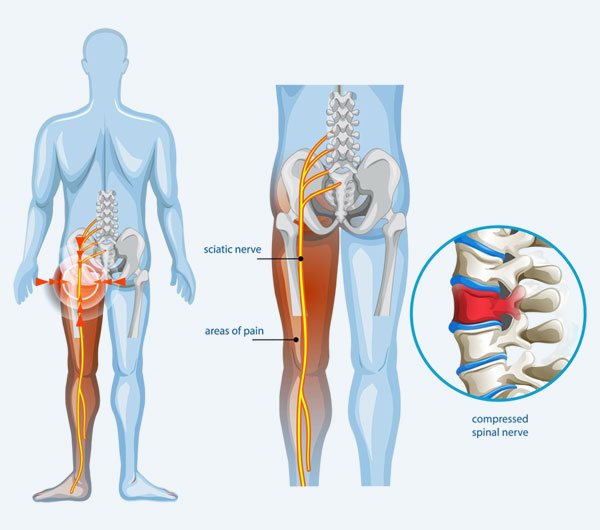Pathophysiology of Sciatica
We aim to assist in clinical judgment, training, research evidence, and/or treatment of patients suffering from sciatic pain. Sciatica is not a disease or anatomically defined. Still, it is a symptom grouping that causes pain due to an underlying mechanism of nerve compression or irritation. Sciatic pain starts in the lower back, runs through the buttocks, and down to the lower leg. Any disturbance along this pathway would cause signs and symptoms of pain, tingling, numbness, and/or weakness in one leg. Sciatica can be:-
- Acute - It lasts from a few days to a few weeks with a sudden onset due to trauma or strain.
- Chronic - This lasts over 12 weeks and originates from structural or degenerative spine changes.
It may happen to anyone, but usually between the ages of 30 and 60 years, sedentary workers, workers with heavy physical jobs, or people with any spine-related problems are more likely to have it.
Causes of Sciatica Pain
Any factor causing irritation or impinging on the sciatic nerve can be considered a cause:-
- Herniated or Slipped Disc - The disc material commonly protrudes to compress the sciatic nerve roots.
- Spinal Stenosis - By narrowing the spinal canal, nerve roots are compressed.
- Degenerative Disc Disease - A result of wear and tear due to aging, intervertebral discs also lose their cushioning, irritating the nerves.
- Spondylolisthesis - A slipped vertebra will pinch the sciatic nerve.
- muscle spasms-piriformis syndrome - The piriformis muscle in the buttocks irritates or compresses the sciatic nerve.
- Trauma or injury - Injuries from accidents, falls, or fractures affecting the spine or pelvis
- Lifestyle and Risk Factors - Obesity, prolonged sitting, poor posture, and lack of physical activity increase the risk of developing sciatica.
Symptoms of Sciatica
Symptoms of sciatica come and go in intensity, whereas they are generally restricted to one side of the body. Symptoms may include:-
- Pain in/from the lumbar area into the buttock, thigh, calf, or foot
- Severe, burning, or stabbing pain aggravated with sitting, coughing, or sneezing
- Numbness or weakness in the affected leg
- Muscle weakness or inability to move the leg or foot
- Sharp pain that feels sudden, like an electric shock
- Constant aching in the lower back, with or without pain in the hip
The severe presentation of symptoms with loss of bowel and bladder control must be evaluated immediately, as they signify cauda equina syndrome, which is a surgical emergency.
Why We Are Different

No
Surgery

30-Minute Procedure

Targets Root Cause

Minimal Downtime

Long-Lasting Results

Proven, Safe Methods
Dr Ekta's Pain Management Clinic Treatment Options for Sciatica
At Dr Ekta's Pain Management Clinic, we utilize non-surgical treatments that effectively treat sciatica with little downtime.
Different medication
- NSAIDs for pain and inflammation
- Muscle relaxants for spasms
- Medications to calm irritated nerves
- A short course of oral steroids (in selected cases)
Exercises and Rehabilitation
- Core-strengthening exercises to stabilize the spine
- Stretching routines to relieve nerve compression
- Posture correction and ergonomic training
- Low-impact aerobic exercises to enhance circulation
Interventional Pain Procedures
- Epidural Steroid Injections (ESIs) deliver anti-inflammatory medication around the irritated nerve roots to alleviate pain and swelling.
- Selective Nerve Root Blocks - Targeting the exact nerve causing pain offers diagnostic insight and pain relief.
- Facet Joint Injections - Helpful when arthritis contributes to sciatic nerve irritation.
- Radiofrequency Ablation (RFA) - Destroys pain-transmitting nerves for long-term relief in chronic sciatica.
- Regenerative Therapies (PRP) - Encourages natural tissue healing and reduces inflammation around the compressed nerves.
Lifestyle and Ergonomics Coaching
- Weight management to reduce spinal load
- Correct lifting techniques
- Advice on ergonomic seating, workstations, and sleep posture
Self-Care & Prevention Strategies
- A lot of movement to avoid prolonged periods of sitting
- Stretching often; emphasize hamstrings and lower back
- Maintain normal body weight; excess weight puts pressure on the spine
- Use chairs that support and firm mattresses
- Keep off high heels; they upset the spine's normal alignment.
- Quit smoking; it speeds up disc degeneration.
FAQs on Sciatica Pain
How will I know whether I have sciatica or just back pain?
Back pain can be more localized, whereas sciatica radiates down the leg along the path of the sciatic nerve. Therefore, if your pain travels into your buttocks and possibly thigh or calf, it could be labeled as sciatica.
Does sciatica normally disappear by itself?
Mild cases may improve with rest, medication, and stretching. Nevertheless, pain that continues for a long time or is severe will require intervention.
Is surgery the only option left for severe sciatica?
It is not. Non-surgical treatments like epidural injections, physiotherapy, and RFA can provide reasonable control to treat almost all cases of sciatica at Dr Ekta's Pain Management Clinic. Usually, surgery is considered only if conservative methods fail.
What is the time frame for healing from sciatica?
Healing time varies. Acute cases of sciatica may improve within 4-6 weeks, but chronic cases can take several months to recover and manage.
Can exercising make sciatica worse?
High-impact exercises or ones done with improper form could worsen the pain in the afflicted area. Physiotherapy under supervision, with low-impact exercises such as swimming or walking, is advised.
Why Choose Dr Ekta's Pain Management Clinic for Sciatica Pain?
- Expertise in Non-Surgical Care - Our doctors specialize in interventional pain management tailored for sciatica.
- Utilization of Cutting-Edge Technology - Our advanced imaging and minimally invasive procedures help to ensure accuracy and safety.
- Comprehensive approach - Medical treatment, physiotherapy, and lifestyle changes are combined for the best results.
- Individualized Treatment Plans - Each patient's care is designed according to the severity of pain, lifestyle, and medical history.
- Patient-Oriented Environment - Compassionate care, reduced waiting times, and holistic support on the way to recovery.
At Dr Ekta's Pain Management Clinic, our specialty is assisting patients in eliminating sciatica pain without surgery, restoring mobility, and regaining quality of life.
Why Choose Us
We’re the most trusted Pain Specialists in West Delhi.
Our expert clinical approach and treatment framework extends beyond just ordinary pain-relief practices to precise and targeted comprehensive pain treatment and management that ensures faster recovery and quicker return to an active life.
With robust expertise in advanced non-surgical Sciatica Pain Treatment in West Delhi, our Pain Specialists at Dr Ekta’s Pain Management Clinic, strives to ensure the best of care for lasting pain relief and comfort.
Here’s why we’re the best at what we do:
- Expertise
- Compassionate Care
- Advanced Techniques
- Personalized Treatment Plans
- Commitment to Quality
- Transparent
 info@drektapainmanagement.com
info@drektapainmanagement.com +91-9560852171
+91-9560852171 E 29/b, Rajouri Garden, New Delhi, 110027
E 29/b, Rajouri Garden, New Delhi, 110027
